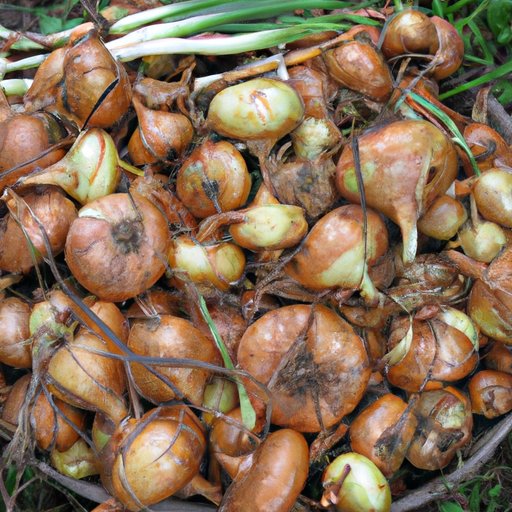
Introduction
If you’re looking to add fresh flavors to your meals, growing onions in your garden is a great place to start. Harvesting onions is easy and rewarding, and it offers many benefits, including cost savings, quality control, and environmental sustainability. In this article, we’ll take you through the step-by-step process of harvesting onions, share tips on timing the harvest, provide creative recipe ideas, and explore ways to store onions after the harvest. Plus, we’ll answer common questions and provide resources for exploring how onions are celebrated around the world.
Step-by-step guide on how to harvest onions
First, gather the necessary tools for harvesting, including gloves, garden forks, and clippers. Next, loosen the soil around the onions with a garden fork, being careful not to damage the bulbs. Once the soil is loosened, gently dig out the onions with the garden fork by prying them out. Handle the onions with care, as they may still be fragile and easily damaged.
After the onions are removed, carefully remove the roots and tops with clippers, leaving a small amount of stem intact to keep the bulb intact. If you aren’t going to use the onions right away, lay them out to cure for a few days by spreading them out on a clean, dry surface and allowing them to dry in a warm, well-ventilated area inside or outside.
Tips for identifying when onions are ready for harvest
Onions are usually ready for harvest when their tops begin to yellow and flop over. When the tops start to wither and turn brown, that’s an indicator it’s time to harvest the onions. Another visual cue is when the neck of the onion starts to soften and bend over. It’s also important to consider the weather and soil conditions when choosing the right time to harvest onions. Harvesting onions after a dry period will mean their skins will be tougher and more difficult to remove.
Creative recipes using freshly harvested onions
There are many ways to use freshly harvested onions in the kitchen. Whether you prefer them caramelized, grilled, or raw, they are tasty, versatile, and add depth to any meal. Try incorporating them in savory tarts, stews, soups, roasted dishes, and more. One of our favorite recipes is onion soup.
Here is a recipe: In a large soup pot, melt butter over medium heat. Add sliced onions and cook until brown and caramelized. Add a dash of salt and pepper and stir in beef broth. Simmer on low heat for 15 minutes.
Benefits of harvesting onions at home versus buying them
Growing onions at home offers many benefits, including better quality, lower costs, and environmental sustainability. Homegrown onions can be grown with minimal pesticide use and picked at their peak, ensuring that they are fresh and flavorful. Buying onions from the store that are shipped long distances are not as fresh and lose flavor and nutritional value as they age. By producing your onions, you can also reduce your carbon footprint.
Ways to store onions after harvest
To maximize the longevity of onions, it’s important to store them correctly. Curing them in a warm, well-ventilated place with plenty of air circulation will allow the outside layer of skin to dry and help prevent decay. When the layer of onion skin is fully dry, onions can be kept in cool, dry places, free from moisture and heat. You can also store onions in mesh bags, cardboard boxes or braided in bunches.
Local onion festivals and events that celebrate the harvest
Onions have a rich cultural history and are celebrated in many different ways around the world. Some notable international onion events include the Onion Market in Bern, Switzerland, and the Onion Festival in Weimar, Germany. Onions are also celebrated in America, including the Goshen Onion Festival in New York and the Vidalia Onion Festival in Georgia.
FAQ about onion harvesting
What do I do if my onions are too small? Small onions can still be harvested, you just need to keep in mind that they have less flavor and won’t store as long.
How can I prevent my onions from rotting? Cure onions completely after harvest to eliminate any moisture that can cause decay. Store them in cool, dry, and well-ventilated places, free from moisture and heat.
Conclusion
Homegrown onions are versatile, flavorful, and easy to grow. By following our simple tips and tricks for harvesting onions, you’ll be able to enjoy a plentiful harvest of this kitchen staple for months to come.





